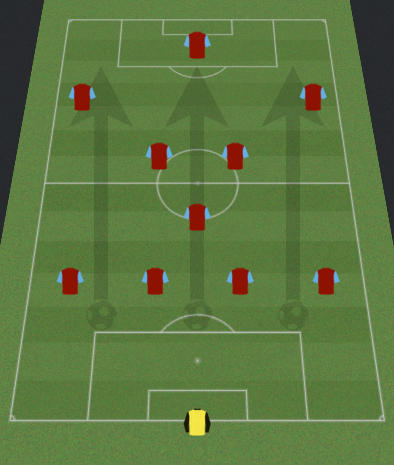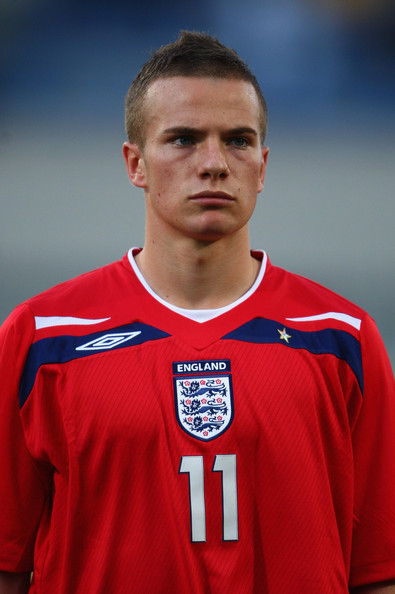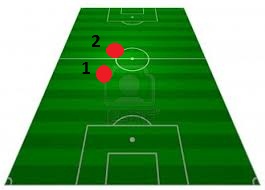The classic 4-3-3
In the wake of yesterday’s 2-0 win at Wembley, I started thinking about the different formations we have seen Moyes try out during the summer, and the 4-3-3 stuck out as the most energetic one.
Discussing formations has always been a case of nitpicking, minor differences and huge disagreements in terms of effectivity. All that aside, I’ll give my personal view of what’s good or bad about the formation, with our squad in centre of the evaluation.
In the picture above, a screenshot from the game Football Manager, a classic 4-3-3, with two wide attackers, a target man striker, two mobile midfielders in advanced roles ahead of the anchor/distributor-type player behind them.
A formation I grew up playing, both as a CDM, CM and striker. I know the ins and outs of how the formation feels, and I’d argue that I got a good feel for the strengths, weaknesses and requirements it brings.
Going back to the introduction, and the sentence about nitpicking on formations, I am going to come out right now and say that the differences between a 4-3-3 and a 4-5-1 are slim. In fact, Teams that form a 4-3-3 shape in attack, very often look like 4-5-1 in defensive periods of their games. In the same way, the 4-5-1 can very much look like the modern 4-2-3-1 (4 -2+3-1) in attack. It is all a matter of player instructions, distinct tasks given by the manager for specific games and what kind of players you possess in your squad.
Moving on from that, we’ve seen different variations of this through the summer. Moyes has tried out a 2-man holding midfield while playing in Asia, with Cleverley or Anderson staying further back alongside Carrick. He tried out a more classic 3-man midfield yesterday, with Giggs and Clevs in advanced positions ahead of Carrick and the differences are looking significant for some players.
I will be the first one to admit that you can pin that down to several different variables, such as (lack of) match fitness, temperature and density in Asia, injuries, morale and so on. But for the sake of a discussion on formations, I’ll disregard that for now and take a look at Cleverley from yesterdays’ game.
After getting a lot of stick from late February 2013 and up until now, both in newspapers and on reddit, Cleverley impressed me a whole lot yesterday. He didn’t seem to catch many peoples’ attention by his play, but I was paying extra attention to him against Wigan. I was looking for who was going to dominate the space where Cleverley usually is in his prime, and where James McCarthy likes to own the area. In a more advanced role, Cleverley didn’t seem to burn all of his energy chasing opponents. He still brought the pressure in his game, but was 20 meters higher up in the pitch when we won the ball. This is huge for a midfielder. Being 10 meters behind the midfield line pretty much forces you to play it sideways or short to someone with more space to hit it forward. Being further up allows you to dictate where the passes go. If you want to turn it from the left to the right, you’ll both have time to do it and to rush forward as the pass leaves your foot.
As shown in the picture above, where 1 is where Cleverley was for huge parts of last season, and for the start of this pre-season, and 2 is where he was yesterday, the difference is very easy to spot. But what does this mean in terms of strategy on the pitch?
First off, being where the 2 is, you are immediately in a position to create danger with runs, short passes or through-balls. It gives you an easier time to involve yourselves in the build-up or preferably counter-attacking play. Being this far up, winning the ball in pressure, is hell to deal with for defenders. One of them have to move out of positions to pressure or mark the man in possession. In turn, this creates space for the front trio to move behind into space. Needless to say, in a solid performance, this opens up the possibility for fast 1-2s, flicks and a passing oriented attacking play. This came very clear in our second goal from Van Persie.
I am not saying that this type of play doesn’t work in other formations, but rather that the 4-3-3 is built upon this type of play.
My idea of the Man United 4-3-3 in action
The strengths of a formation like this, is that it is very easy to involve your full-backs offensively. Evident in Evras’ performance yesterday. The CDM player gets a lot of space and time with the ball due to the two advanced players’ ability to draw opponents into marking them further up the pitch. It gives you the possibility to use Welbeck in a free left role, which he did brilliantly in, and you could use Zaha wide like yesterday, or go with two roaming players up front.
The midfield is built on the idea that you have very dynamic advanced players, that can take turns on working hard defensively or staying put for a counter-attack or high pressure a bit further up.
A key point, that I feel like we didn’t do very well at in this, was involving the striker in the attacks. Van Persie was on the move and available a lot of the time, but the temptation of playing it wide, made for a very predictable attack. Taking advantage of Van Persies ability to hold on to the ball and pass it on or through is great, and needs to be utilized if we are to play this formation again.
The major weaknesses to this formation is that it requires very fit advanced midfielders. In this formation, with the players on the team sheet above, Cleverley and Anderson are supposed to do most of the running. Both are injury-prone, and one of them has a tendency to fall out of games. It is also developed around the idea that your front-3 consist of a player that is a very good finisher but also able to drop down, recieve the ball and distribute. For this, your wingers need to be in threatening shape, and able to beat their man or 1-2 past players to create danger behind enemy lines. Last season, none of our wingers delivered play to that standard.
Another potential issue is when you face teams playing a more clear 4-2-3-1 formation, which seems to be the prefered flavor of the top teams in the 2010-2013 period. With two midfielders at the back to pick up your advanced ones, this leaves your own anchor against 2 or 3 attacking players of the opposition. It requires a physical, strong and hard-working player to lead the charge. At the moment, depth in midfield is the key issue for our team. One injury and we seem like a whole different team. We would need midfield signings to be able to use this as a main formation.



